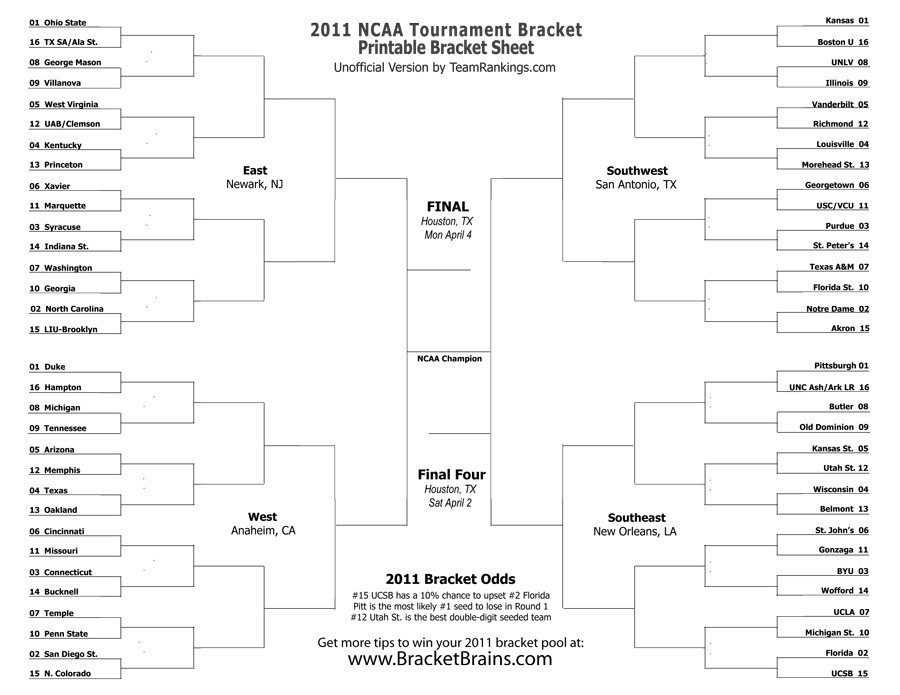
When my wife and I first started dating, I warned her up front: for all of March, I become a crazy sports lunatic – more so than usual – and can not be disturbed every week through Thursday – Sunday. I have since dragged her into my little world of crazy – she is an Ohio State fan – so at least now I have someone to join in my month-long episode of yelling rants and curses at the TV.
This post is meant to be a guide for those that either have a passing interest in the game and look to learn more or for those looking to brush up on how it all works for their office pool. Welcome to the show.
What is “March Madness”?
“March Madness” is an informal term for the NCAA Division I Men’s College Basketball National Championship Tournament (say THAT five times fast). The term refers to the tournament being played throughout March (weekly, Thursdays through Sundays), culminating in the Final Four and National Championship at the beginning of April.
How many teams are in this tournament?
In 2012, 68 teams will be selected/given automatic bids to enter. The teams are seeded 1 through 16, in each of the four “regions”, with the winners of each region meeting in New Orleans for the “Final Four”.
How are teams selected or given automatic bids?
Thirty one teams are given automatic bids for winning their respective conference tournaments. A list of current automatic bids/conference tournament winners is available on CBS. The remaining 37 slots are filled by a Selection Committee on “Selection Sunday” (March 11, 2012), based on a team’s season. One of the main tools used by the Committee is the Ratings Percentage Index, a measurement of each team’s wins and losses when compared with strength of schedule.
How are teams seeded in each region?
Each region is seeded by the Selection Committee on Selection Sunday, based on their RPI and play in conference tournaments. Unlike football, the rankings handed out throughout the season (AP Poll, Coaches’ Poll, etc) have no bearing on the seedings during the tournament. Since 2011, the weakest eight teams as deemed by the Committee, play in the “First Four” with the four winners being formally entered into the bracket. The top seeds (#1 – #4) are generally given games closer to home for the first two rounds.
What does a bracket look like?
Below is a sample bracket of the tournament from 2011. Take note of the most important factor, and why this is called “The Madness”: there is no consolation round. One loss and your season is over. If you have a bad shooting day, your defence doesn’t play like it should, or a million other things than can (and will) go wrong on any given day; they all result in a long bus ride home.

What is a “Cinderella Team”? What is the lowest seed ever to make it to the Final Four?
The term “Cinderella” is usually given to a lower seed (greater than #10) that wins their first two games over higher-ranked opponents. The lowest seed to ever make the Final Four was a #11, which has occurred three times: LSU (1986), George Mason (2005) and Virginia Commonwealth University (2011). The lowest seed to ever win a National Championship was #8 Villanova, in 1985.
When are the games played? What’s this “Sweet Sixteen” nonsense?
The “Sweet Sixteen” is the name given to the Round of 16. Currently, each round is nicknamed the following, with teams remaining and days played in brackets:
– First Round (68; Tuesday after Selection Sunday)
– Round of 64 (64; Thursday and Friday after Selection Sunday)
– Round of 32 (32; Saturday and Sunday after Selection Sunday)
– “Sweet Sixteen” (16; Thursday and Friday, second weekend)
– “Elite Eight” (8; Saturday and Sunday, second weekend)
– “Final Four” (4; Saturday, third weekend)
– “National Championship” (2; Monday, day after third weekend)
Got any other notes/tips for my office pool?
– A #16 seed has never beat a #1. Ever. So, don’t even bother picking it.
– All four #1 seeds in the Final Four has only ever happened once, in 2008. So advancing all four #1s to the Finals may not be the best choice.
– “There are 2^63 or 147,573,952,589,676,412,928. (9.2 quintillion) possibilities for the possible winners in a 64 team NCAA bracket, making the odds of randomly picking a perfect bracket 9.2 quintillion to 1.” (Wikipedia) So when one of your teams loses, rest assured, you still have a chance.
March is my favourite time of year. It’s getting warmer out, the birds start singing and you never know when a #12 will drop a #5 from the tournament like a bad habit. And it all begins this Sunday.
Let The Madness begin.
… and that’s the last word.






